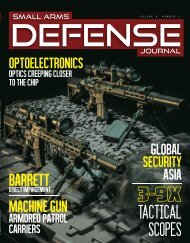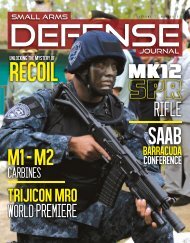SAR 18#6
You also want an ePaper? Increase the reach of your titles
YUMPU automatically turns print PDFs into web optimized ePapers that Google loves.
early upgrades to pre-EH### pistols<br />
that required an enhanced trigger bar<br />
that would increase the sear/striker<br />
engagement. These improved early<br />
trigger bars had a “+” stamped on the<br />
top rear portion near the area of striker<br />
engagement. While this upgraded<br />
trigger bar had a distinct shape, this<br />
author has seen at least one example<br />
of an earlier shaped part that has a<br />
bronze/gold color.<br />
Shortly after the change from<br />
two-letter to three-letter serial numbers,<br />
a second line was added to the lower<br />
cartouche on the grip with two additional<br />
patent numbers. The next internal<br />
upgrade in this approximate chronology<br />
was angled cuts made to the interior<br />
of the frame to relieve the back two<br />
corners where the locking piece sits.<br />
Without this modification, those two<br />
corners were prone to the initiation of<br />
vertical cracks in the polymer due to<br />
the repeated impact of the corners of<br />
the metal locking piece to the frame.<br />
The relief cuts seemed to prevent the<br />
occurrence and could also be added to<br />
older models after the cracks had begun<br />
(essentially removing the cracks<br />
in the process of making the cuts<br />
at their location).<br />
As with other internal upgrades,<br />
because these were often done by the<br />
factory after production, their presence<br />
tells less about the age of the pistol<br />
than their absence. Hypothetically,<br />
were the people at Glock, Inc. to discover<br />
an old batch of early generation<br />
2 serialized frames; they would surely<br />
complete these upgrades before assembling<br />
them into pistols to be sold as<br />
new. Likewise, pistols returned to the<br />
factory as trade-in towards new models<br />
might also have similar upgrades.<br />
The list of generation 2 changes<br />
above can be described sequentially<br />
Glock<br />
Top: Midway through the 2nd generation,<br />
relief cuts were added to the rear cutout<br />
area for the locking block. Earlier models<br />
tended to develop tiny cracks in the polymer<br />
of that area due to the impact of the<br />
locking block corners during recoil. For a<br />
time, Glock would retrofit earlier guns if<br />
requested, although, there’s little indication<br />
these small cracks were more than a<br />
cosmetic issue.<br />
Right: During the 1994-2004 ban period,<br />
some magazines for the subcompact<br />
Glock 26 and 27 pistols were delivered<br />
with “RESTRICTED. . .” markings and extended<br />
floor plates because their capacity<br />
exceeded the 10-round limit.<br />
www.smallarmsreview.com 55 <strong>SAR</strong> Vol. 18, No. 6









